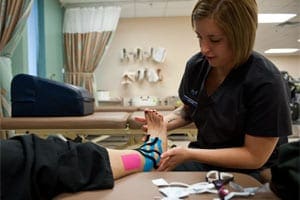statFor some women, it's about making an elegantement at special events or being a couple…

What is Kinesio Taping?
 The Kinesio Taping Method is a form of physiological therapy practiced by chiropractors, physical therapists, and specialists in sports medicine that uses specialized tape applied to the skin to give support to muscles as they flex or to prevent over-contraction. The treatment (and the patented tape used to implement it) was created by Dr. Kenzo Kase in 1973, and was originally used primarily by orthopedists, chiropractors, and other medical practitioners. In the 1980s, however, the Kinesio Taping Method gained wider appreciation when it was used by Japanese Olympic basketball players. Since then it has been used extensively for physiotherapy and to enhance sports performance by many athletes, including many in the recent Sochi Winter Olympic Games.
The Kinesio Taping Method is a form of physiological therapy practiced by chiropractors, physical therapists, and specialists in sports medicine that uses specialized tape applied to the skin to give support to muscles as they flex or to prevent over-contraction. The treatment (and the patented tape used to implement it) was created by Dr. Kenzo Kase in 1973, and was originally used primarily by orthopedists, chiropractors, and other medical practitioners. In the 1980s, however, the Kinesio Taping Method gained wider appreciation when it was used by Japanese Olympic basketball players. Since then it has been used extensively for physiotherapy and to enhance sports performance by many athletes, including many in the recent Sochi Winter Olympic Games.
The technique is practiced by specialists who have completed a course of study with the Kinesio Taping Association and who have been certified by that organization. In theory, the method affects physiological changes to several body systems, including the joints, the circulatory and lymphatic systems, and the muscles and fascia. It is used to change and improve muscle tone, correct movement patterns, improve posture, and improve lymphatic circulation.
Its benefits are that the taping gives support and stability to joints and muscles without affecting circulation and normal range of motion. Like most chiropractic modalities, it is based on the body’s own natural healing process, particularly the study of kinesiology.
Muscles control not only our movements, but also the flow of venous and lymph fluids, so the developers of the Kinesio Taping Method hoped to find a way to use elastic tape to train the muscles to work in not only a more efficient manner, but a more healthy manner. The method has thus not only been used for sports medicine, but also for a wide variety of other therapeutic purposes. These include reducing inflammation and relaxing muscles as well as treating arthritis, carpal tunnel syndrome, knee and shoulder conditions, lower back strain and pain, hamstring and groin injuries, plantar fasciitis, whiplash, and pre- and post-surgical edema.
One of the reasons that athletes are attracted to the Kinesio Taping Method is that the nature of what they do often leads to injuries. The method is claimed to reduce the healing time after such injuries, and speed the rehabilitation process. Although scientific and medical evidence supporting the method’s effectiveness has not been conclusive, there is already so much anecdotal evidence that it is no longer unusual to see athletes wearing the brightly colored Kinesio Tex Tape during their warm-ups, and even during their athletic performances.
If you are interested in finding out more about the Kinesio Taping Method, contact your chiropractor and ask how it might be effectively integrated with other chiropractic services.




